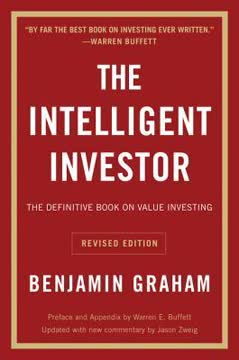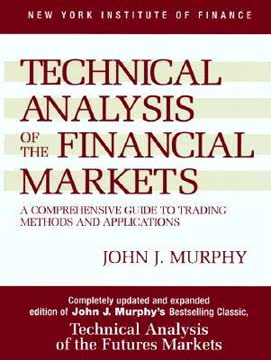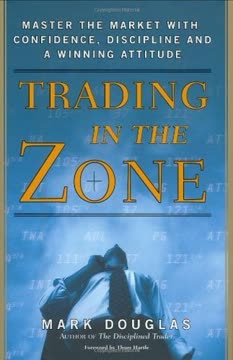نکات کلیدی
1. روش وایکاف: درک ساختار و چرخههای بازار
"بازارهای مالی یک موجود زنده هستند که بهطور مداوم به دلیل تعامل مستمر بین خریداران و فروشندگان در حال تغییرند."
چرخهها و ساختارهای بازار. روش وایکاف چارچوبی برای درک رفتار بازار از طریق تحلیل قیمت و حجم ارائه میدهد. این روش چهار مرحله اصلی در چرخههای بازار را شناسایی میکند: انباشت، روند صعودی، توزیع و روند نزولی. این مراحل تحت تأثیر اقدامات معاملهگران بزرگ و آگاه (دستهای قوی) و معاملهگران کمتر آگاه (دستهای ضعیف) قرار دارند.
اجزای کلیدی:
- حرکت قیمت در امواج با اندازههای مختلف
- روندها: صعودی، نزولی و جانبی
- دامنههای معاملاتی: انباشت و توزیع
- تغییر شخصیت (ChoCh) بین مراحل
درک این ساختارها به معاملهگران این امکان را میدهد که نقاط چرخش بالقوه را شناسایی کرده و معاملات خود را با نیروهای غالب بازار هماهنگ کنند.
2. سه قانون بنیادی: عرضه و تقاضا، علت و معلول، تلاش و نتیجه
"قانون علت و معلول به ما میگوید که برای اینکه یک اثر وجود داشته باشد، ابتدا باید علتی وجود داشته باشد که آن را ایجاد کند؛ و اینکه اثر بهطور مستقیم با علت متناسب خواهد بود."
پایههای تحلیل بازار. روش وایکاف بر سه قانون بنیادی استوار است که رفتار بازار را govern میکند:
- قانون عرضه و تقاضا: حرکات قیمت نتیجه عدم تعادل بین فشار خرید و فروش هستند.
- قانون علت و معلول: حرکات قیمت متناسب با آمادگی (علت) که پیش از آن وجود دارد، هستند.
- قانون تلاش و نتیجه: حجم (تلاش) باید حرکات قیمت (نتیجه) را تأیید کند.
این قوانین چارچوب منطقی برای تفسیر عمل بازار و پیشبینی حرکات آینده فراهم میکنند. با درک تعامل بین این قوانین، معاملهگران میتوانند تصمیمات آگاهانهتری درباره جهت بازار و نقاط چرخش بالقوه اتخاذ کنند.
3. انباشت و توزیع: شناسایی کمپینهای بازار
"در فرآیند انباشت، معاملهگران بزرگ محیطی از ضعف شدید ایجاد میکنند."
تاکتیکهای معاملهگران حرفهای. انباشت و توزیع فرآیندهایی هستند که در آن معاملهگران بزرگ بهطور سیستماتیک موقعیتها را ایجاد یا تصفیه میکنند. این کمپینها معمولاً در دامنههای معاملاتی رخ میدهند و زمینهساز حرکات روند بعدی میشوند.
ویژگیهای کلیدی:
- انباشت: جذب عرضه، ایجاد پایهای برای حرکت صعودی آینده
- توزیع: جذب تقاضا، آمادهسازی برای حرکت نزولی آینده
- تاکتیکهای دستکاری: ایجاد برداشتهای نادرست از ضعف یا قدرت
- آزمایشها: بررسی سطوح عرضه یا تقاضا
شناسایی این فرآیندها به معاملهگران این امکان را میدهد که خود را در کنار معاملهگران حرفهای قرار دهند و حرکات عمده بازار را پیشبینی کنند.
4. پنج مرحله ساختارهای بازار: از متوقف کردن روندها تا حرکات جدید
"تحلیل مرحلهای به ما کمک میکند تا فرآیندهای انباشت و توزیع را ساختاربندی کنیم و زمینه کلی بازار را برای ما فراهم کند."
چارچوب ساختاری. روش وایکاف ساختارهای بازار را به پنج مرحله متمایز تقسیم میکند:
- مرحله A: متوقف کردن روند قبلی
- مرحله B: ایجاد علت
- مرحله C: آزمایش
- مرحله D: روند درون دامنه
- مرحله E: روند خارج از دامنه
هر مرحله ویژگیها و رویدادهای خاصی دارد که به معاملهگران کمک میکند تا شناسایی کنند بازار در کدام مرحله از چرخه خود قرار دارد. این چارچوب زمینهای برای تصمیمات معاملاتی فراهم میکند و به پیشبینی حرکات آینده بازار کمک میکند.
5. رویدادهای کلیدی در ساختارهای بازار: شناسایی اقدامات قیمتی بحرانی
"لرزش کلید رویدادی است که تمام معاملهگران وایکاف در انتظار آن هستند."
اقدامات بحرانی بازار. روش وایکاف چندین رویداد کلیدی را در ساختارهای بازار شناسایی میکند که تغییرات مهمی در عرضه و تقاضا را نشان میدهند:
- حمایت/عرضه مقدماتی
- اوج (فروش/خرید)
- واکنش/رالی خودکار
- آزمایش ثانویه
- بهار/افزایش
- نشانهای از قدرت/ضعف
- آخرین نقطه حمایت/عرضه
درک این رویدادها به معاملهگران کمک میکند تا نقاط چرخش بالقوه و فرصتهای معاملاتی با احتمال بالا را شناسایی کنند. هر رویداد بینشهایی درباره تعادل قدرت بین خریداران و فروشندگان و جهت آینده بازار ارائه میدهد.
6. استراتژیهای معاملاتی: بهرهبرداری از تحلیل ساختار بازار
"تصمیمات معاملاتی و سرمایهگذاری ما بر اساس سه عنصری خواهد بود که من معتقدم مهمترین موارد برای در نظر گرفتن در خوانش اختیاری نمودارها هستند: زمینه، ساختارها و مناطق معاملاتی."
رویکرد استراتژیک. معاملهگران وایکاف بر سه منطقه معاملاتی اصلی تمرکز میکنند:
- مرحله C: لرزشها یا آزمایشهای بالقوه
- مرحله D: حرکات روند درون دامنه و آزمایشهای شکست
- مرحله E: ادامه روند و انباشت/توزیع مجدد
استراتژیهای معاملاتی بر اساس:
- شناسایی ساختار و مرحله فعلی بازار
- شناسایی رویدادهای کلیدی و سیگنالهای حرکات قیمتی
- هماهنگ کردن معاملات با روند غالب و زمینه زمانی بزرگتر
- استفاده از تحلیل حجم برای تأیید حرکات قیمت
با پیروی از این اصول، معاملهگران میتوانند تنظیمات با احتمال بالا را با نسبتهای ریسک-پاداش مطلوب شناسایی کنند.
7. مدیریت ریسک و اندازهگیری موقعیت: حفاظت از سرمایه و حداکثر کردن سود
"یک روش بسیار مفید برای انجام مدیریت ریسک مناسب، محاسبه اندازه موقعیت بر اساس فاصله بین سطح ورود و سطح توقف ضرر است."
حفاظت از سرمایه. مدیریت ریسک مؤثر برای موفقیت بلندمدت در معاملات بسیار حیاتی است. اصول کلیدی شامل:
- ریسک ثابت در هر معامله (مثلاً 1% از اندازه حساب)
- اندازهگیری موقعیت بر اساس فاصله توقف ضرر
- نسبتهای ریسک-پاداش مطلوب (حداقل 1:1، ترجیحاً بالاتر)
- سطوح توقف ضرر و برداشت سود واضح بر اساس ساختار بازار
مدیریت ریسک مناسب اطمینان میدهد که هیچ معاملهای نمیتواند بهطور قابل توجهی بر عملکرد کلی حساب تأثیر بگذارد و امکان سودآوری مداوم را در طول زمان فراهم میکند.
8. تحلیل حجم: تفسیر مشارکت و علاقه بازار
"حجم مقدار سهام (سهام، واحدها، قراردادها) است که دست به دست شده است. زمانی که معاملهگران بزرگ به یک امنیت علاقهمند هستند، این موضوع در حجم معامله شده منعکس خواهد شد."
بینشهای حجم. تحلیل حجم یکی از ارکان روش وایکاف است که بینشهای حیاتی درباره مشارکت و علاقه بازار ارائه میدهد. مفاهیم کلیدی شامل:
- تأیید حجم حرکات قیمت
- حجم اوج که سیگنالدهنده معکوسهای بالقوه است
- کاهش حجم که نشاندهنده عدم علاقه است
- تکنیکهای تحلیل گسترش حجم (VSA)
با تفسیر حجم در کنار حرکات قیمت، معاملهگران میتوانند اعتماد به نفس پشت حرکات بازار را ارزیابی کرده و نقاط چرخش بالقوه را با دقت بیشتری شناسایی کنند.
9. زمینه پادشاه است: هماهنگ کردن معاملات با ساختارهای بزرگتر بازار
"قاعده حیاتی در مورد زمینه واضح است: در جهت ساختار بزرگتر معامله کنید."
نگاه جامع. درک زمینه بازار برای موفقیت در معاملات بسیار حیاتی است. این شامل:
- تحلیل چندین بازه زمانی
- شناسایی روند غالب در بازههای زمانی بالاتر
- شناسایی مرحله فعلی ساختار بازار
- هماهنگ کردن معاملات با جهت بزرگتر بازار
با در نظر گرفتن زمینه وسیعتر بازار، معاملهگران میتوانند از مبارزه با روند غالب پرهیز کرده و احتمال موفقیت خود را در معاملات فردی افزایش دهند.
10. قدرت عمل قیمت: خواندن زبان بازار
"مفهوم نوارهای مهم بسیار مهم است زیرا وقتی تغییر در شخصیت را مشاهده میکنیم، احتمالاً آن نوارهای معکوس را خواهیم دید."
ارتباط بازار. عمل قیمت زبان اصلی بازار است که نبرد جاری بین خریداران و فروشندگان را فاش میکند. مفاهیم کلیدی عمل قیمت در روش وایکاف شامل:
- نوارهای مهم: دامنه وسیع، حجم بالا، بسته شدن نزدیک به انتها
- تغییر شخصیت (ChoCh): تغییر در رفتار بازار
- آزمایشها: قیمت که سطوح قبلی را با ویژگیهای متفاوت بازدید میکند
- لرزشها: شکستهای کاذب که برای به دام انداختن معاملهگران طراحی شدهاند
با توسعه مهارت در خواندن عمل قیمت، معاملهگران میتوانند بهتر نیتهای بازار را تفسیر کرده و تصمیمات معاملاتی آگاهانهتری اتخاذ کنند.
آخرین بهروزرسانی::
FAQ
What's "The Wyckoff Methodology in Depth" about?
- Overview: "The Wyckoff Methodology in Depth" by Rubén Villahermosa is a comprehensive guide on trading financial markets using the Wyckoff Method, a technical analysis approach.
- Focus: The book emphasizes logical trading strategies based on the principles of supply and demand, cause and effect, and effort and result.
- Structure: It is divided into parts that cover market movements, the Wyckoff Method, fundamental laws, accumulation and distribution processes, events, phases, trading strategies, and case studies.
- Purpose: The book aims to equip traders with the knowledge to interpret market actions and make informed trading decisions.
Why should I read "The Wyckoff Methodology in Depth"?
- In-depth Analysis: The book provides a detailed exploration of the Wyckoff Method, making it suitable for traders seeking to deepen their understanding of market dynamics.
- Practical Application: It offers practical insights and strategies that can be applied to real-world trading scenarios, enhancing decision-making skills.
- Comprehensive Coverage: With its structured approach, the book covers everything from basic concepts to advanced trading techniques, making it a valuable resource for both beginners and experienced traders.
- Author's Expertise: Rubén Villahermosa brings his extensive knowledge and experience in technical analysis and trading strategies to the book, providing readers with credible and actionable insights.
What are the key takeaways of "The Wyckoff Methodology in Depth"?
- Market Movements: Understanding how markets move through waves, price cycles, and trends is crucial for effective trading.
- Wyckoff Method: The methodology involves analyzing market structures, fundamental laws, and the processes of accumulation and distribution.
- Trading Strategies: The book emphasizes the importance of context, structures, and trading areas in making informed trading decisions.
- Case Studies: Real-world examples illustrate the application of the Wyckoff Method, providing practical insights into its effectiveness.
What is the Wyckoff Method according to Rubén Villahermosa?
- Technical Analysis Approach: The Wyckoff Method is a technical analysis approach that focuses on understanding market movements through the principles of supply and demand.
- Three Fundamental Laws: It is based on the laws of supply and demand, cause and effect, and effort and result, which help traders interpret market actions.
- Market Structures: The method involves analyzing market structures such as accumulation and distribution to predict future price movements.
- Flexibility and Objectivity: The Wyckoff Method combines flexibility in analyzing market conditions with objective principles to guide trading decisions.
How do markets move according to "The Wyckoff Methodology in Depth"?
- Wave Patterns: Markets move in waves of different sizes, which are not random but reflect the underlying supply and demand dynamics.
- Price Cycles: The market follows a cycle of accumulation, uptrend, distribution, and downtrend, which traders can use to identify trading opportunities.
- Trend Analysis: Trends are categorized into bullish, bearish, and lateral, and understanding these trends is key to trading in harmony with the market.
- Trend Assessment: Tools such as strength/weakness analysis and lines help traders assess the health of trends and make informed decisions.
What are the three fundamental laws in the Wyckoff Method?
- Law of Supply and Demand: This law states that price movements are determined by the balance between supply and demand, with prices rising when demand exceeds supply and falling when supply exceeds demand.
- Law of Cause and Effect: It suggests that market movements are the result of a cause, such as accumulation or distribution, and the effect is the subsequent trend.
- Law of Effort and Result: This law emphasizes the relationship between volume (effort) and price movement (result), with harmony indicating trend continuation and divergence suggesting a potential reversal.
What is the process of accumulation and distribution in the Wyckoff Method?
- Accumulation: This process involves large traders absorbing available stock from the market, creating a base for a future uptrend.
- Distribution: In contrast, distribution involves large traders selling stock, leading to a market top and a subsequent downtrend.
- Characteristics: Accumulation is characterized by decreasing volume and volatility, while distribution shows high volume and volatility.
- Market Control: Understanding these processes helps traders identify when the market is controlled by buyers or sellers, guiding their trading decisions.
What are the key events in the Wyckoff Method?
- Preliminary Stop: The first attempt to halt a trend, indicating a potential market turn.
- Climax: The culmination of a trend, marked by a significant volume and price movement.
- Reaction: A movement in the opposite direction, signaling a change in market sentiment.
- Test: An evaluation of market commitment, confirming the presence or absence of interest in a particular direction.
- Shaking: A deceptive move to expel weak traders, often preceding a trend movement.
How are phases used in the Wyckoff Method?
- Phase A: Stops the previous trend and returns the market to a state of balance.
- Phase B: Builds the cause for the subsequent effect, involving stock absorption or distribution.
- Phase C: Tests the market's commitment, often involving a shakeout or upthrust.
- Phase D: Initiates the trend movement within the range, confirming the direction.
- Phase E: Represents the trend movement out of the range, driven by the imbalance created in previous phases.
What trading strategies are recommended in "The Wyckoff Methodology in Depth"?
- Contextual Trading: Emphasizes trading in favor of the larger structure and avoiding trades on the wrong side of the market.
- Structure Analysis: Focuses on understanding market structures to identify potential trading opportunities.
- Trading Areas: Identifies key trading areas that act as price magnets, providing liquidity for large traders.
- Primary Positions: Recommends trading in specific phases and events, such as Phase C (shakeout), Phase D (trend within range), and Phase E (trend out of range).
What are some of the best quotes from "The Wyckoff Methodology in Depth" and what do they mean?
- "The price does not move between two points in a straight line; it does so in a wave pattern." This quote emphasizes the importance of understanding wave patterns in market movements.
- "A cycle is considered to be complete when all stages of the cycle are observed: accumulation, uptrend, distribution, and downtrend." It highlights the cyclical nature of markets and the need to recognize these stages for effective trading.
- "The Wyckoff method has passed the test of time." This underscores the enduring relevance and effectiveness of the Wyckoff Method in trading.
- "The key to everything is in the types of orders that are executed." This quote points to the significance of understanding order types and their impact on market movements.
How does "The Wyckoff Methodology in Depth" apply to real-world trading scenarios?
- Case Studies: The book includes case studies of various financial instruments, such as the S&P500, Bitcoin, and currency pairs, demonstrating the application of the Wyckoff Method.
- Practical Insights: These examples provide practical insights into how the methodology can be used to analyze market conditions and make informed trading decisions.
- Market Fractality: The book illustrates the concept of market fractality, showing how similar structures and patterns appear across different time frames and assets.
- Adaptability: The Wyckoff Method's adaptability to various market conditions and instruments is highlighted, reinforcing its value as a versatile trading approach.
نقد و بررسی
کتاب روش وایکوف بهطور عمیق نقدهای متفاوتی دریافت کرده است و بهطور کلی امتیاز 3.99 از 5 را کسب کرده است. خوانندگان از پوشش جامع ساختار بازار و اصول وایکوف قدردانی میکنند و اطلاعات فراوان و بینشهای آن در مورد رفتار اپراتورها را تحسین میکنند. با این حال، برخی از محتوای تکراری، زبان انگلیسی ضعیف و عدم جهتگیری واضح انتقاد میکنند. بسیاری آن را پیچیده میدانند و توصیه میکنند که برای درک کامل مفاهیم، چندین بار مطالعه شود. در حالی که برخی آن را منبعی عالی برای درک حرکات بازار میدانند، دیگران احساس میکنند که فاقد کاربرد عملی و وضوح در تمایز بین مراحل بازار است.
Similar Books














